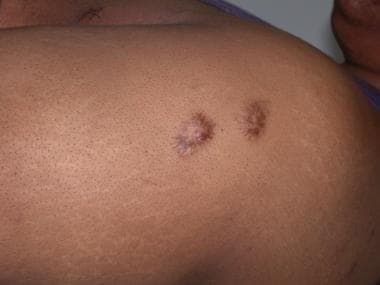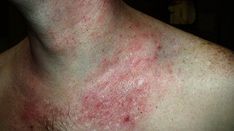Practice Essentials
Excoriation (skin-picking) disorder, also known as psychogenic excoriation, dermatillomania or neurotic excoriation, is characterized by the conscious repetitive picking of skin that leads to skin lesions and significant distress or functional impairment. [1] Neurotic excoriations can be initiated by some minor skin pathology (eg, insect bite, eczema, folliculitis, or acne), but it can also be independent of any pathology. See the image below.
Signs and symptoms
Findings from the history may include the following:
-
History of picking, digging, or scraping the skin
-
Presence or absence of an inciting incident
-
Personal problems (eg, history of abuse)
-
Psychiatric history that includes a comorbid mental disorder
-
Nasal ulcerations
-
Facial acne
Psychiatric and medical diagnoses that should be considered include the following:
-
Depression
-
Trichotillomania
-
Anxiety
-
Tic disorder
-
Obsessive-compulsive disorder (OCD)
-
Body dysmorphic disorder
-
Somatoform disorders
-
Borderline personality disorder
-
Delusions of parasitosis
-
Scabies
See DDx for more detail.
Physical findings may include the following:
-
Crusted or noncrusted lesions
-
Erosions and scars with angulated borders
-
Variable quantity of erosions and scars (from several to hundreds)
-
Occasional evolution into frank ulcers
See Presentation for more detail.
Diagnosis
Specific DSM-5 criteria for excoriation disorder are as follows:
-
Recurrent skin-picking, resulting in lesions
-
Repeated attempts to decrease or stop skin picking
-
The skin picking causes clinically significant distress or impairment in important areas of functioning
-
The skin picking cannot be attributed to the physiologic effects of a substance or another medical condition
-
The skin picking cannot be better explained by the symptoms of another mental disorder
Diagnostic studies that may be considered for ruling out other conditions include the following:
-
Complete blood count (CBC) with differential
-
Chemistry profile
-
Determination of thyrotropin levels
-
Fasting plasma glucose level
-
Cancer workup
-
Chest radiography
-
Skin biopsy
See Overview for more detail.
Management
General management principles include the following:
-
Setting limits for the protection of both the physician and patient
-
Creating an accepting, empathic, and nonjudgmental environment
-
Closely supervising symptomatic dermatologic care
-
Attempting to develop a therapeutic relationship in which psychological issues may be addressed and which may permit referral to a psychiatrist as appropriate
-
Avoidance of issues of etiology (confrontation is counterproductive)
Pharmacotherapy may include the following:
-
Antipsychotic agents
-
Antianxiety agents
-
Antidepressants
-
Topical cortisone agents
-
Antiepileptic agents
Other treatment methods that may be considered are as follows:
-
Hypnosis
-
Physical barriers (eg, an Unna sleeve)
See Treatment and Medication for more detail.
Background
Excoriation (skin-picking) disorder involves the conscious creation of neurotic excoriations by means of repetitive scratching (although acts of rubbing skin, lancing, squeezing or biting can also be used and individuals may use tweezers, fingernails or other objects). [2] Neurotic excoriations should be distinguished from dermatitis artefacta, in which patients create lesions for secondary gain. Neurotic excoriations can be initiated by some minor skin pathology, such as an insect bite, folliculitis, callouses, scabs, or acne, but it can also be independent of any pathology. Triggers include emotions such as stress, anger, and anxiety, and sedentary activities such as watching television, reading, boredom, and feeling tired. [1]
Because no significant underlying pathology is present in the skin, neurotic excoriations are best understood as a psychological process with dermatologic manifestations. Many doctors lack an extensive understanding of neurotic excoriations and their treatment. [3] The complex dynamic underlying the urge to create a neurotic excoriation is yet to be fully explained. [4] Dermatologists are aware of this complex dynamic and continue to grapple with it. [3]
Because patients create neurotic excoriations, the lesions have the quality of an "outside job"—that is, clean, linear erosions, crusts, and scars that can be hypopigmented or hyperpigmented. The erosions and scars of neurotic excoriations often have irregular borders and are usually similar in size and shape. They occur on areas that the patient can scratch, particularly the extensor surfaces of the extremities, the face, and the upper part of the back. The distribution is bilateral and symmetric.
The manifestations of neurotic excoriations vary widely, ranging from unconscious picking at the skin to uncontrollable picking at lesions to remove imaginary foreign bodies. Picking is usually episodic and irregular, but it can be constant. The picking can have the quality of a ritual and may take place in a state of dissociation.
The inability to stop picking despite efforts to do so can lead to feelings of shame, anxiety, and depression. Individuals often spend a large amount of time on repetitive picking and/or camouflaging (taking up several hours per day in severe cases). They often avoid situations where skin lesions can be detected that could lead to social embarrassment, or have loss of productivity at school or work due to this avoidance behaviors. Medical sequelae such as infections, scarring, and even serious physical disfigurement can occur. Excoriation (skin picking) disorder is also associated with other comorbidities including other body-focused repetitive behavior disorders – with trichotillomania being the most common. Obsessive–compulsive disorder (OCD) and body dysmorphic disorder (BDD) are also more prevalent in individuals with excoriation disorder than in the general population. Mood and anxiety disorders are also common. [1]
Pathophysiology and Etiology
Neurotic excoriations are due either to an underlying psychopathology or to the formation of habit. Accordingly, their pathophysiology is poorly understood.
Shah and Fried found neurotic excoriations to be among the most common factitious skin diseases in children; they further noted that factitious skin disease is less common in children and can often be linked to comorbid psychiatric diagnoses or a psychosocial stressor that can be identified. [5] Subsequently, a task force of dermatologists, psychiatrists, and psychologists worked to place neurotic excoriations in their proper category in dermatology and psychology, finding that mental disorders with pathologic activities could underline the disease. [6]
The causes of neurotic excoriations are manifold and can relate to picking as a means of resolving stress or, as noted, to some underlying psychopathology. [7] Some believe neurotic excoriations to be a physical manifestation of obsessive-compulsive disorder (OCD).
Epidemiology
Skin-picking is more common than expected, and thought to be underreported, with prevalence ranging between 1.4% and 5.4%. [1, 8] The rate of neurotic excoriations among patients at dermatologic clinics is 2%. The rate of neurotic excoriations in patients with pruritus is 9%. Most studies have found the mean patient age at onset to be in the range of 30–45 years although onset often occurs during adolescence. [9] There is variability among studies regarding gender prevalence; one study found nearly equal gender distribution in those with excoriation (skin-picking) disorder with women perceiving themselves as less attractive and men having more alcohol consumption. [10]
In other studies, 52–92% of patients with neurotic excoriations have been female.2 [8] Excoriation (skin-picking) disorder is more commonly found in individuals with first-degree relatives who have the disorder or in individuals with obsessive-compulsive disorder. Studies have found that trichotillomania and excoriation disorder co-occur more often than expected. Both disorders have substantial similarities in clinical characteristics and overlapping risk factors. [1]
Prognosis
Except in mild transient cases triggered by an immediate stress, the prognosis for cure is poor. The condition tends to wax and wane with the circumstances of the patient’s life. Often, however, excoriation disorder can be controlled if the underlying psychological illness is controlled. Patients need intervention but sometimes have difficulty in changing the habit of picking. Without medical and psychiatric treatment, excoriation disorder tends to be a chronic condition. Untreated excoriations can result in scarring or infection, or tissue damage that may require antibiotics or surgery. Rarely, synovisits has been reported in the wrists due to chronic picking. [2]
-
A picker's nodules with no crust and a scarred appearance.
-
A picker's nodule with crusted lesions.











